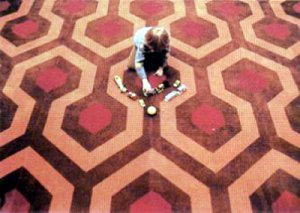May 24, 2006
CONSENSUAL HALLUCINATIONS
My abstract for the Cultural Fictions event at Goldsmiths:
 |  |
Stephen King's The Shining (1977) and William Gibson's Neuromancer (1984) both centrally concern what Gibson calls 'consensual hallucinations'. The major Events of The Shining and Neuromancer take place in an abstract zone that exists only in the 'nonspace of the mind' (Gibson). But this 'mental nonspace' is in no way a logically private interiority. On the contrary, King and Gibson's novels demonstrate that capital colonizes all levels of the psyche at precisely the same moment that it destroys any concept of public space. Cyberspatial sociality depends upon a kind of Oedipalized telepathos; in the Matrix, the same signal is beamed out to all OedIPods.
Cyberspace would be nothing if we didn't believe in it, but what would we be, now, outside cyberspace/ capital?
Capital - the 'decoding of all previous social formations' (Deleuze-Guattari) - reveals that there is no social without the fictional, but, as the fictional consistencies which formerly glued together the social dissolve into neuromantic capital's 'fictional quantities', it becomes possible to see that capitalism is essentially hyperstitional. Its spectral hype-dynamics use (un)belief as the motor of an auto-exciting feedback circuit that ceaselessly reprocesses (what counts as) reality.
Time is out of joint. Archaisms return at the terminal point of History. Spectres stalk the Matrix: the leisured ghosts partying in The Shining's Overlook anticipate a permanent restoration of ruling class power. In Neuromancer, the withered claw of the incestuous Gothic Tessier-Ashpool clan still holds the key to cyberspace.
But there are other spectres too.... Out beyond the Matrix OedIPod, another kind of consensual hallucination lurks, a ghost of a chance, the return of something which never happened: Telecommunism...
Posted by mark at May 24, 2006 05:46 PM | TrackBack